
ppl_03_e2
.pdf
ID: 3658
Customer: Oleg Ostapenko E-mail: ostapenko2002@yahoo.com Customer: Oleg Ostapenko E-mail: ostapenko2002@yahoo.com
CHAPTER 3: DIRECTION
By examining Figure 3.7c, we can see that whenever magnetic variation is West, that is, whenever Magnetic North lies to the West of True North, we must add the magnetic variation to any true heading in order to obtain the magnetic heading. In other words, when magnetic variation is West, the magnetic heading is always greater than the true heading.
If we were in a location where Magnetic North lay to the East of True North, we would have to subtract the magnetic variation from any true heading in order to obtain the magnetic heading. (See Figure 3.7d.)
It is now straightforward to determine that, in order to make good the true heading of 072° (T) from Ledbury to Wellesbourne Mountford, we must add the magnetic variation of 3° West and steer 075° (M).
The sense in which magnetic variation is applied to true heading in order to obtain magnetic heading may be remembered from the rhyme:
VARIATION WEST, MAGNETIC BEST.
VARIATION EAST, MAGNETIC LEAST.
If there were absolutely no wind blowing on the day a pilot wished to fly cross country, and if the indications of his magnetic compass were entirely error free, he could calculate the magnetic heading to fly, in the way that we have just demonstrated, and steer that heading on his compass. In real life, however, there is almost always wind to allow for. But, allowing for wind is a reasonably straightforward thing to do, and you will learn how to include a correction for wind in your calculation of magnetic heading in a subsequent chapter. For the moment, we will look at the possible errors which may be displayed by a magnetic compass so that, knowing your magnetic heading, you may be confident about the heading to steer on the compass.
THE MAGNETIC COMPASS.
The direct indicating magnetic compass of the type illustrated in Figure 3.8, is fitted to all aircraft, from the simplest light aircraft to the most modern glass cockpit airliner. In airliners, the magnetic compass is a standby instrument, while in many light aircraft it is still the primary instrument for indicating direction.
Figure 3.8 The Simple Magnetic Compass.
37

Order: 6026
Customer: Oleg Ostapenko E-mail: ostapenko2002@yahoo.com
Customer: Oleg Ostapenko E-mail: ostapenko2002@yahoo.com
CHAPTER 3: DIRECTION
A vertical lubber line on the glass window of the bowl enables the heading to be read from the compass card. The direct indicating magnetic compass is designed to indicate direction relative to the Earth’s magnetic poles.
In ideal conditions, the magnet at the heart of the aircraft’s magnetic compass, will point at all times to the Earth’s Magnetic North and South Poles. Theoretically, as the aircraft changes direction the compass magnet remains aligned with the Earth’s magnetic field, and the pilot is, thus, able to read off his aircraft’s magnetic heading. However, as we learn below, there are several reasons why the magnet inside the compass may not always lie North-South, leading to errors in compass indications.
The main causes of error in the indications of the magnetic compass are:
•the presence within the aircraft of magnetic influences such as those produced by metal components, and the electrical fields of certain items of equipment.
•compass dip.
COMPASS DEVIATION.
The Magnetic Compass is not only sensitive to the Earth’s magnetic field but also to the magnetic fields of electrically driven instruments and metallic objects within the cockpit. The presence of these “secondary” magnetic fields within the cockpit will cause the Magnetic Compass to deviate from pointing towards Magnetic North.
The angle between Magnetic North and the direction which is indicated by the magnetic compass is called the angle of deviation or, simply, deviation.
Another way of expressing this idea is to say that local magnetic influences within the aircraft cause the compass to indicate Compass North and not Magnetic North. Deviation, then, is the angular difference between Magnetic North and Compass North.
Deviation can be East or West of Magnetic North as depicted in Figures 3.9a and 3.9b. A deviation of 2° to the West of Magnetic North can be written as 2°W or +2°. Deviation to the East of Magnetic North of 2° can be written as 2°E or -2°.
38
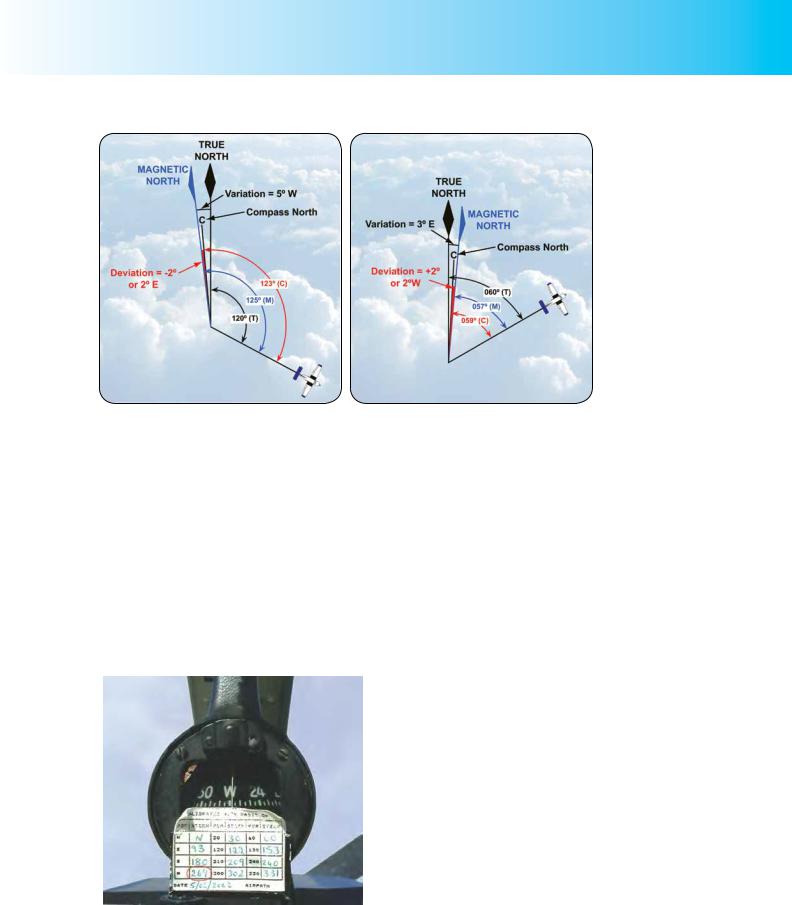
ID: 3658
Customer: Oleg Ostapenko E-mail: ostapenko2002@yahoo.com Customer: Oleg Ostapenko E-mail: ostapenko2002@yahoo.com
CHAPTER 3: DIRECTION
Figure 3.9a True Heading, Magnetic Heading |
Figure 3.9b True Heading, Magnetic Heading |
and Compass Heading. Deviation = -2°. |
and Compass Heading. Deviation = +2°. |
When the aircraft is turning, because the compass magnet attempts to remain aligned in a North-South direction, the relative position of the compass magnet and the magnetic materials within the aircraft changes.
Therefore deviation varies with indicated magnetic heading.
Consequently, the extent of compass deviation has to be measured on a series of different headings if it is to be corrected. This is usually done by conducting what is called a compass swing. Measured deviation is then eliminated as far as possible by making adjustments to the compass itself by means of correcting screws. Once deviation has been reduced as far as possible, the residual deviation is recorded on a compass deviation card or a “heading to steer” card, which is located in close proximity to the compass. (See Figure 3.10.)
Figure 3.10 Compass Deviation Card, in the form of “headings to steer.”
In Figure 3.10 the compass deviation card indicates that for the aircraft to take on a magnetic heading of 270°(M) (West), the pilot must steer 269° by the compass. The compass deviation card in Figure 3.10 also tells the pilot that he must steer 093° by the compass to obtain a magnetic heading of 090° (M) (East).
There are other deviation corrections on the card in Figure 3.10, but notice that magnetic headings of 180° (M), 360° (M) (North) and 060° (M) require no correction.
Always remember to check your compass deviation card when setting your magnetic heading on a cross-country flight. Compass deviation errors are usually small, and
39

Order: 6026
Customer: Oleg Ostapenko E-mail: ostapenko2002@yahoo.com
Customer: Oleg Ostapenko E-mail: ostapenko2002@yahoo.com
CHAPTER 3: DIRECTION
it is difficult, if not impossible, to fly to an accuracy of one degree using the magnetic compass, but a pilot should strive to achieve the highest degree of accuracy he can in navigating his aircraft. For instance, if a pilot did not notice the 3° deviation error for a magnetic heading of 090° (M), that could mean the pilot being 3 nautical miles off track, after 60 nautical miles, even if he could fly with 100% accuracy.
The heading that the pilot finally steers by his compass in order to eliminate deviation is often called the compass heading. In Figure 3.10, in order to make good a magnetic heading of 120°(M), the pilot must steer 122° (C) by the compass, the deviation being +2°.
The Relationship Between True Heading, Magnetic Heading, and Compass Heading.
In practice, when embarking on a cross-country flight, having measured true heading from your chart, and determined magnetic heading by applying the local magnetic variation and wind, you do not have to calculate compass deviation. That will already have been done when the aircraft last underwent a compass swing. As the pilot, what you have to do, as we have already mentioned, is to refer to the compass deviation card when setting heading, so that you know what compass heading to steer to make good your calculated magnetic heading.
Compass deviation on the deviation card may appear either as in Figure 3.10 as a heading to steer, or in the form of +1, +2, -1, -2, etc. If the deviation is given as plus, you add that number of degrees to your magnetic heading to get compass heading. If the deviation is given as minus, you subtract that number of degrees from your magnetic heading to get compass heading. Remember also to check before flight that the card is valid (within 3 years of the date of compass swing).
However, pilots should make a point of knowing the relationship between true heading, magnetic heading and compass heading. When recalculating heading and groundspeed, mid track, for example, after discovering that the forecast wind was inaccurate, such knowledge can help tremendously with in-flight mental dead reckoning. Be aware, too, that questions on this relationship are much loved by those who devise questions for examination papers.
Having measured True heading (that is the true bearing of your desired track), magnetic Variation is applied to obtain the Magnetic heading; finally compass Deviation is applied to the magnetic heading to arrive at the Compass heading.
If you remember the line, “Thanks Very Much Dear Chap”, the initial letters will remind you of the sequence to be followed to convert a True heading into a Compass heading.
Remember, it does not matter whether we are talking about variation or deviation, “East is always least and West is always best.” In an examination, make a point of sketching the relative angles as in Figure 3.9a and 3.9b; then it will be obvious whether you need to add or subtract.
Here is an example calculation:
If the true heading is 075°(T), the magnetic variation is 4°W and the deviation 1°E, what is the compass heading?
Apply “Thanks Very Much Dear Chap”, and “East is least and West is best”.
40

ID: 3658
Customer: Oleg Ostapenko E-mail: ostapenko2002@yahoo.com Customer: Oleg Ostapenko E-mail: ostapenko2002@yahoo.com
CHAPTER 3: DIRECTION
The sequence we must work through then starts at true heading; then we apply variation to get magnetic heading, followed by deviation to get compass heading.
Magnetic variation is West so magnetic heading is better (in other words larger) than true heading; that makes the magnetic heading 075° + 4° = 079°(M). Deviation is East so compass heading is less than magnetic heading. That makes the compass heading 079° – 1° = 078° (C).
At other times, an examination question may express compass deviation in terms of plus and minus sign, e.g. -1°, +2°. You should note that, when expressed in this way, a deviation of -1° means that Compass North is East of Magnetic North. The reasoning behind this is that when Compass North moves
East, headings measured relative to Compass North are smaller. Conversely, a deviation of +2° means that Compass North is West of Magnetic North. This is because when Compass North moves West, headings measured relative to Compass North are larger.
If you are required to relate compass heading to true heading, starting with the compass heading, then work the other way round: compass heading corrected for compass deviation gives magnetic heading which, when corrected for magnetic variation, gives true heading.
This sequence of operations can be remembered by memorising the words: “Cadbury’s Dairy Milk, Very Tasty”.
Here is an example of this sequence of working.
If the compass heading is 276°, the magnetic variation is 3°W and the deviation is -1°, what is the true heading?
Apply “Cadbury’s Dairy Milk, Very Tasty”, and “East is least and West is best”.
Here, the sequence we work through starts at compass heading; then we apply deviation to get magnetic heading, followed by variation to get true heading.
Deviation is -1° which means 1° East. Because “East is least”, compass heading must be the smaller number; therefore, magnetic heading must be larger than compass heading. So magnetic heading is 276° +1° = 277(M). Variation is West so the magnetic heading must be greater than the true heading. True heading is, therefore, smaller than magnetic heading; so true heading is 277° - 3° = 274°(T).
As mentioned above, if you draw out the situation for any calculation you are asked to perform, in the format of Figures 3.9a and 3.9b, you should be able to confirm the correctness of your answer.
Of course, in real life, when you climb into your aircraft, applying deviation from the compass deviation card is straight forward, and there is no need to work your compass heading out from first principles, as we have been doing here. You must, however, understand the principle of the calculations.
41
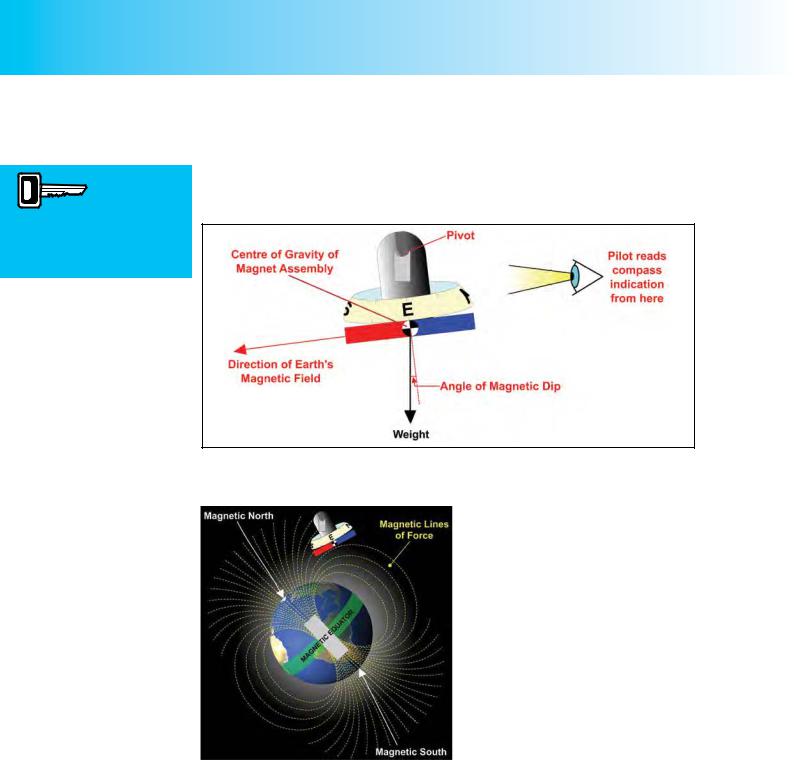
Order: 6026
Customer: Oleg Ostapenko E-mail: ostapenko2002@yahoo.com
Customer: Oleg Ostapenko E-mail: ostapenko2002@yahoo.com
CHAPTER 3: DIRECTION
The angle between the
vertical and horizontal
components of the Earth’s magnetic field is the Angle of Dip.
MAGNETIC DIP.
A second principal cause of error in the indications of the magnetic compass is the phenomenon of magnetic dip. Magnetic dip gives rise to the acceleration and turning errors in compass indications that you will learn about below.
Figure 3.11 Dip in a magnetic compass.
Magnetic Dip.
Figure 3.12 Magnetic Dip.
Except near the Earth’s ‘magnetic equator’, where the Earth’s magnetic lines of force are parallel to the Earth’s surface, one end of a freely-suspended magnet will dip below the horizontal, pointing to the nearer magnetic pole. For example, to the North of the Magnetic Equator, the north-seeking pole of a compass magnet will dip, as shown in Figure 3.11 and 3.12.
The closer to the Earth’s magnetic poles that a freely-suspended magnet is located, the greater will be the magnetic dip. Magnetic dip in the United Kingdom is about 66° to the vertical. Over the magnetic poles, the dip is 90°.
LINEAR ACCELERATION ERRORS IN THE MAGNETIC COMPASS.
As a result of magnetic dip, the indications of the magnetic compass are subjected to errors when the aircraft is either accelerating or decelerating linearly, or executing a turn.
Acceleration Errors.
Direct reading magnetic compasses are subject to errors during linear acceleration and linear deceleration.
Most manoeuvres which cause the centre of gravity of a freely-suspended magnet
42
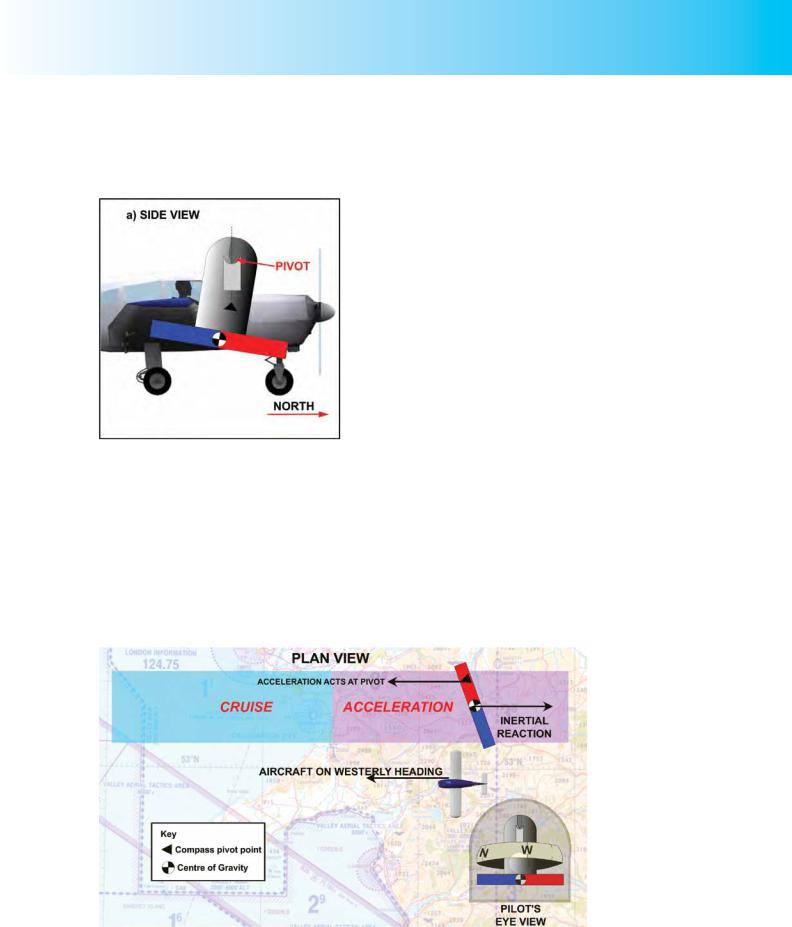
ID: 3658
Customer: Oleg Ostapenko E-mail: ostapenko2002@yahoo.com Customer: Oleg Ostapenko E-mail: ostapenko2002@yahoo.com
CHAPTER 3: DIRECTION
assembly to move away from its position beneath the pivot - See Figure 3.13 - will produce an error in the indication of a compass so as to show an apparent turn when no turn is present.
Figure 3.13 In the Northern Hemisphere, a magnetic compass with dip as shown here. The C of G of the magnet assembly is beneath and behind the pivot.
However, if the manoeuvre displaces the centre of gravity to the North or South of its usual position beneath the pivot, so that the centre of gravity and pivot are still in the plane of the magnetic lines of force, the magnet assembly merely changes its north-south dip angle, with no rotation in azimuth,andconsequentlynoerror. There are, therefore, no linear acceleration errors in compass indications when the aircraft is on a heading of 360º or 180º. Conversely, as you might expect, linear acceleration errors are greatest when the aircraft is heading 090º or 270º.
Note, that turning and linear acceleration errors occur only where there is significant magnetic dip, so acceleration errors are very small near the Magnetic Equator.
When dip is present, the centre of gravity of the pendulously suspended magnet is not directly under the pivot. (See Figure 3.14.) Therefore, when an aircraft accelerates on an easterly or westerly heading, the inertial reaction at the magnet’s centre of gravity causes the suspended magnet to be “left behind” so that the compass’s plane of rotation is no longer horizontal; the magnet can now rotate partly in the vertical plane, and this position allows the magnet to tilt downward to follow the earth’s magnetic field. This rotation is seen as an apparent turn towards North.
Figure 3.14 During acceleration on a westerly or an easterly heading, a magnetic compass indicates an apparent turn towards North.
43
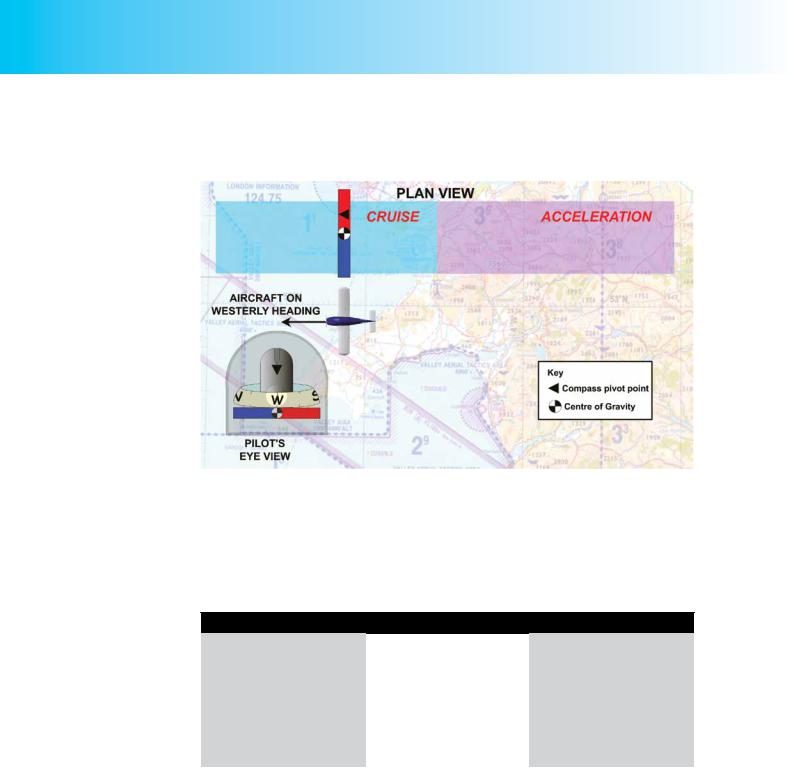
Order: 6026
Customer: Oleg Ostapenko E-mail: ostapenko2002@yahoo.com
Customer: Oleg Ostapenko E-mail: ostapenko2002@yahoo.com
CHAPTER 3: DIRECTION
Once linear acceleration is complete and the aircraft is again flying at constant speed on the easterly or westerly heading, no acceleration force acts on the magnet’s centre of gravity, and the compass reading is again steady and correct. (See Figure 3.15.)
Figure 3.15 At constant speed, compass reading is again correct.
Accelerations on both westerly and easterly headings will result in an erroneous indication towards North. Conversely, decelerations will indicate an apparent turn towards South.
The table below summarises the acceleration errors of the magnetic compass in the
Northern Hemisphere.
LINEAR ACCELERATION ERRORS IN THE NORTHERN HEMISPHERE
Heading |
Acceleration |
Deceleration |
Northerly |
No Error |
No Error |
Southerly |
No Error |
No Error |
Easterly |
Indicates apparent turn |
Indicates apparent turn |
|
North |
South |
Westerly |
Indicates apparent turn |
Indicates apparent turn |
|
North |
South |
Figure 3.16 Table of linear acceleration errors for a magnetic compass in the Northern
Hemisphere.
Turning Errors in a Magnetic Compass.
A turning error in a compass indication is a particular type of acceleration error. When an aircraft turns at a constant speed, it is subject to centripetal acceleration towards the centre of the turn. This acceleration, which is a result of the aircraft continuously changing direction, is caused by the centripetal force generated by the banked wings of the aircraft. The centripetal force acts on all parts of the aircraft, including the centre of gravity of the compass magnets and on the magnet pivot point. This situation leads to the magnetic compass displaying indication errors during turns.
44
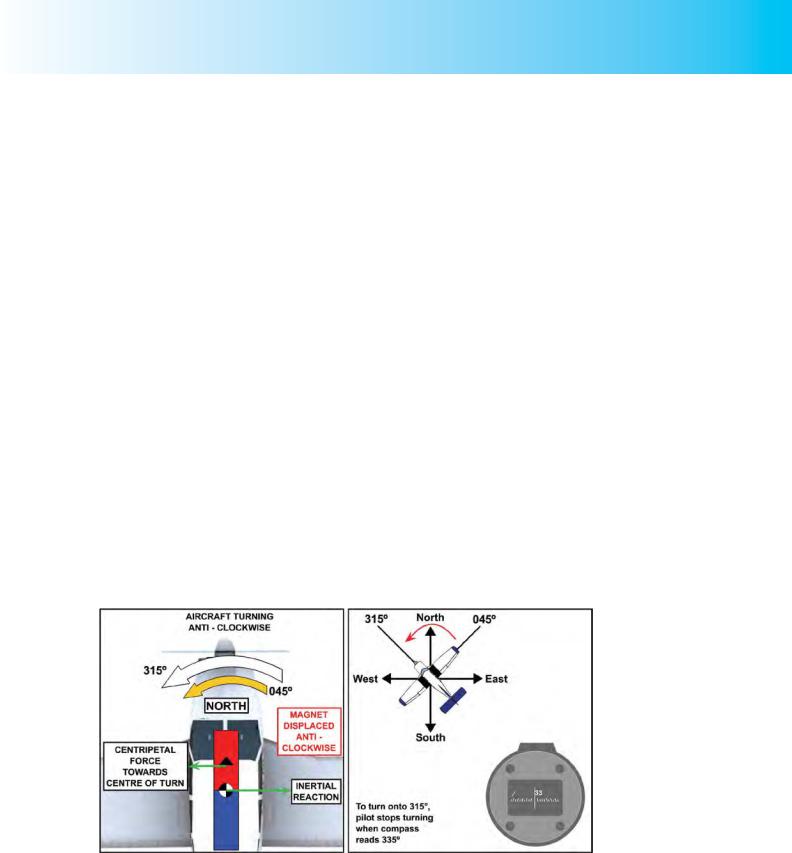
ID: 3658
Customer: Oleg Ostapenko E-mail: ostapenko2002@yahoo.com Customer: Oleg Ostapenko E-mail: ostapenko2002@yahoo.com
CHAPTER 3: DIRECTION
Turning errors are maximum when turning through North and South, and a minimum when turning through East and West.
Away from the regions of the magnetic equator, because of the effect of magnetic dip, the compass’s centre of gravity will be displaced from a position directly beneath the pivot point. In a turn, the aircraft accelerates towards the centre of the turn, and therefore an acceleration force acts through the pivot towards the centre of the turn, while the inertial reaction force acts outwards through the centre of gravity. This situation results in the magnet assembly tending to ‘swing out’ from the turn, rotating the magnet assembly around the pivot point and producing a turning error. (See Figure 3.17.)
Turning errors are usually more significant than linear acceleration errors for two reasons. Firstly, because they are inherently of greater magnitude, (up to about 30deg passing North/South headings), resulting from the greater displacement of the magnet assembly in turns; and, secondly, turns are likely to last longer than linear accelerations. However, prolonged turns that pass through East and West will eventually reduce the error to zero.
Turning Through North and South.
Whenever the pilot turns through the nearer pole (that is, the North Pole in the Northern Hemisphere, or the South Pole in the Southern Hemisphere), the aircraft and compass magnet rotate in the same direction. (See Figure 3.17.) In this situation, the relative movement between the compass card (attached to the magnet) and the compass housing will be small, and the compass card will appear to react sluggishly. Therefore, the pilot must roll out of the turn early, just before the indicated heading is reached. Figure 3.17 shows an aircraft turning from 045° onto a heading of 315°, in the Northern Hemisphere. The pilot must roll out “early”, at an indication of about 335°. If turning from 315° back to 045°, the pilot could roll out “early” at about 025°. Such conditions are typical in rate 1 turns.
Figure 3.17 Turning through North in the Northern Hemisphere. Roll out “early” onto heading.
Whenever the pilot turns through the further pole (that is, the South Pole in the Northern Hemisphere, or the North Pole in the Southern Hemisphere), the aircraft and the compass rotate in opposite directions. (See Figure 3.18, overleaf.) In this situation, the relative movement between the compass card and the compass housing will be large and the compass card will react in a lively manner. Therefore, the pilot must roll out of the turn just after the indicated heading is reached. Figure 3.18 shows an aircraft turning from 135° onto a heading of 225°, in the Northern Hemisphere. The
45

Order: 6026
Customer: Oleg Ostapenko E-mail: ostapenko2002@yahoo.com
Customer: Oleg Ostapenko E-mail: ostapenko2002@yahoo.com
CHAPTER 3: DIRECTION
pilot must roll out “late”, at an indication of about 245°. If turning from 225° onto 135° the pilot would also roll out “late”, at an indication of about 115°.
Figure 3.18 Turning through South in the Northern Hemisphere. Roll out “late” onto heading.
Summary of Compass Turning Errors in the Northern Hemisphere.
In the Northern Hemisphere, when rolling out of a turn onto a magnetic heading, using a direct indicating magnetic compass, the pilot should memorise the mnemonic “NESL”: NORTH (rollout) EARLY, SOUTH (rollout) LATE. Errors will be zero passing East and West, up to 30 degrees passing North and South and pro rata in between.
COMPASS SERVICEABILITY CHECKS.
Prior to take off, the following checks of the magnetic compass should be carried out. The checks are done before engine start, during taxying or after lining up on the runway, as appropriate.
Prior to Engine Start.
Check that there is no obvious damage to the compass body or glass, such as dents or cracks, and that the compass is securely mounted.
Check that the compass liquid is free from sediment and discolouration, either of which would indicate corrosion, resulting in increased pivot friction.
The compass liquid should also be free from bubbles, which would probably indicate a leaking seal. Turbulence and manoeuvres would cause any bubbles to move about, creating eddies which could disturb the magnet system.
The compass reading can also be checked for gross errors when you first enter the aircraft by verifying that the compass is giving a sensible reading.
During Taxying.
Check the compass reading while taxying the aircraft. The compass readings should decrease when turning left, and increase when the aircraft is turning right.
After lining up.
Just before take-off, check the compass reading against the runway heading.
46
